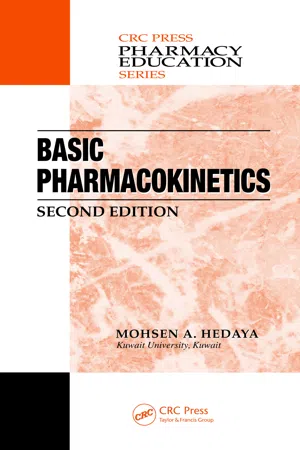
- 595 pages
- English
- PDF
- Available on iOS & Android
Basic Pharmacokinetics
About This Book
Knowledge of pharmacokinetics is critical to understanding the absorption, distribution, metabolism, and excretion of drugs. It is therefore vital to those engaged in the discovery, development, and preclinical and clinical evaluation of drugs, as well as practitioners involved in the clinical use of drugs. Using different approaches accessible to a wide variety of readers, Basic Pharmacokinetics: Second Edition demonstrates the quantitative pharmacokinetic relations and the interplay between pharmacokinetic parameters.
After a basic introduction to pharmacokinetics and its related fields, the book examines:
- Mathematical operations commonly used in pharmacokinetics
- Drug distribution and clearance and how they affect the rate of drug elimination after a single dose
- Factors affecting drug absorption following extravascular drug administration, the rate and extent of drug absorption, and drug bioequivalence
- The steady-state concept during constant rate intravenous infusion and during multiple drug administration
- Renal drug elimination, drug metabolism, multicompartment models, nonlinear pharmacokinetics, and drug administration by intermittent intravenous infusion
- Pharmacokinetic-pharmacodynamic modeling, noncompartmental pharmacokinetic data analysis, clearance concept from the physiological point of view, and physiological modeling
- Clinical applications of pharmacokinetics, including therapeutic drug monitoring, drug pharmacokinetics in special populations, pharmacokinetic drug-drug interactions, pharmacogenomics, and applications of computers in pharmacokinetics
-
Accompanying the book are downloadable resources with self-instructional tutorials and pharmacokinetic and pharmacokinetic-pharmacodynamic simulations, allowing visualization of concepts for enhanced comprehension. This learning tool received an award from the American Association of Colleges of Pharmacy for innovation in teaching, making it a valuable supplement to this essential text.
Frequently asked questions
Information
Table of contents
- Front Cover
- Contents
- Preface
- Author
- Chapter 1: Introduction to Pharmacokinetics
- Chapter 2: Review of Mathematical Fundamentals
- Chapter 3: Drug Pharmacokinetics Following a Single IV Bolus Administration : Drug Distribution
- Chapter 4: Drug Pharmacokinetics Following a Single IV Bolus Administration : Drug Clearance
- Chapter 5: Drug Pharmacokinetics Following a Single IV Bolus Administration : The Rate of Drug Elimination
- Chapter 6: Drug Absorption Following Extravascular Administration : Biological, Physiological, and Pathological Considerations
- Chapter 7: Drug Absorption Following Extravascular Administration : Molecular and Physicochemical Considerations
- Chapter 8: Drug Absorption Following Extravascular Administration : Formulation Factors
- Chapter 9: Drug Pharmacokinetics Following Single Oral Drug Administration : The Rate of Drug Absorption
- Chapter 10: Drug Pharmacokinetics Following Single Oral Drug Administration : The Extent of Drug Absorption
- Chapter 11: Bioequivalence
- Chapter 12: Drug Pharmacokinetics during Constant Rate IV Infusion : The Steady-State Principle
- Chapter 13: Steady State during Multiple Drug Administration
- Chapter 14: Renal Drug Excretion
- Chapter 15: Metabolite Pharmacokinetics
- Chapter 16: Nonlinear Pharmacokinetics
- Chapter 17: Multicompartment Pharmacokinetic Models
- Chapter 18: Drug Pharmacokinetics Following Administration by Intermittent Intravenous Infusion
- Chapter 19: Pharmacokinetic–Pharmacodynamic Modeling
- Chapter 20: Noncompartmental Approach in Pharmacokinetic Data Analysis
- Chapter 21: Physiological Approach to Hepatic Clearance
- Chapter 22: Physiologically Based Pharmacokinetic Models
- Chapter 23: Therapeutic Drug Monitoring
- Chapter 24: Pharmacokinetics in Special Patient Populations
- Chapter 25: Pharmacokinetic Drug–Drug Interactions
- Chapter 26: Pharmacogenetics : The Genetic Basis of Pharmacokinetic and Pharmacodynamic Variability
- Chapter 27: Applications of Computers in Pharmacokinetics
- Chapter 28: The Companion CD
- Solutions for the Practice Problems
- Back Cover